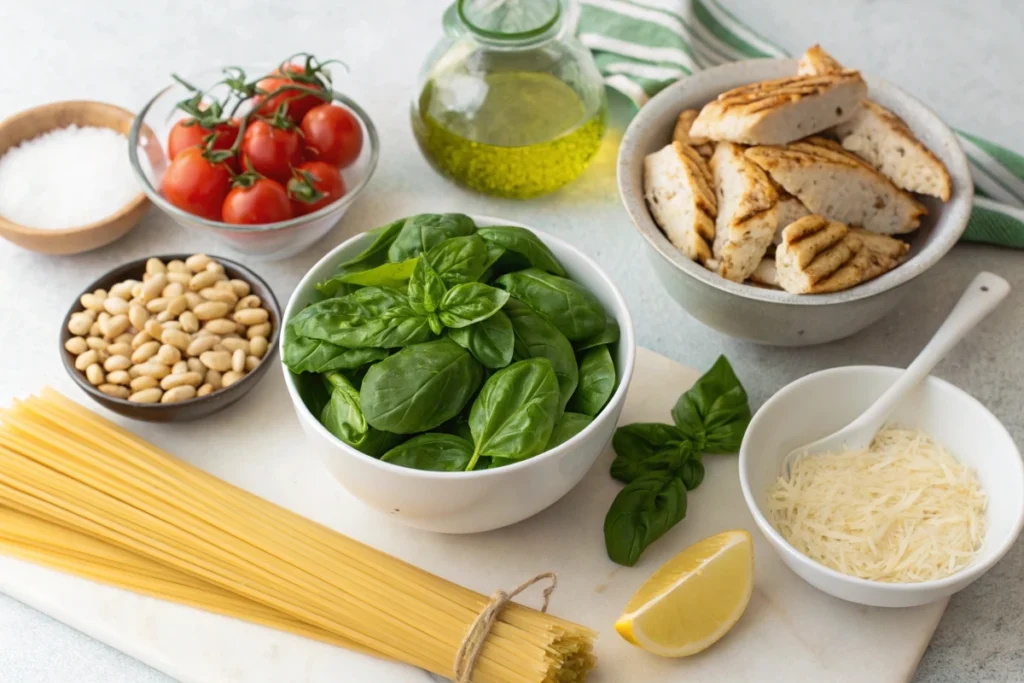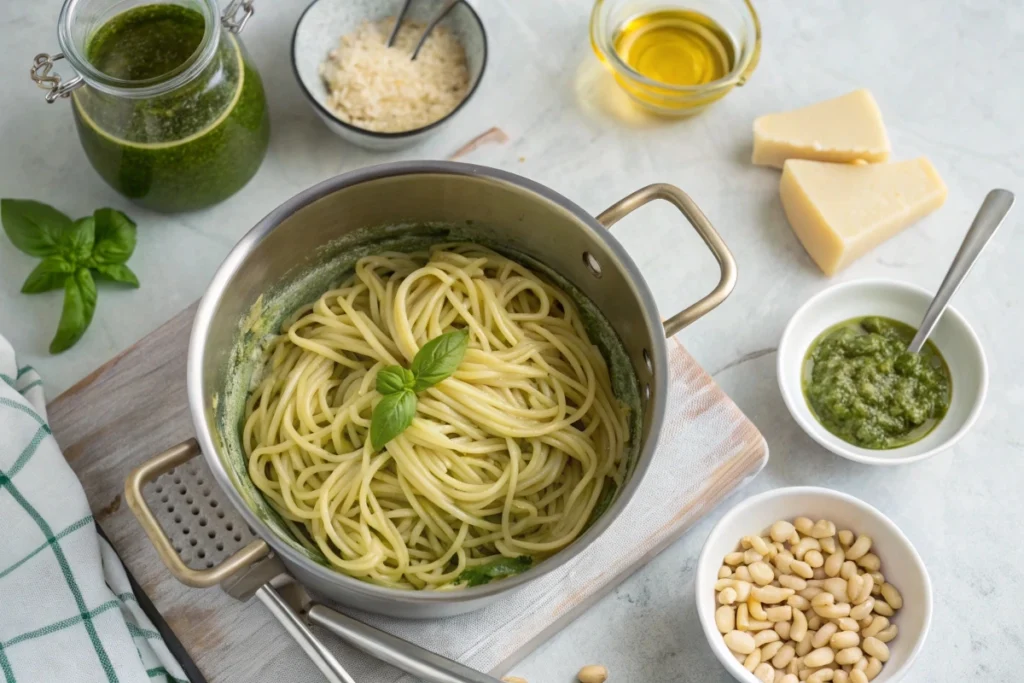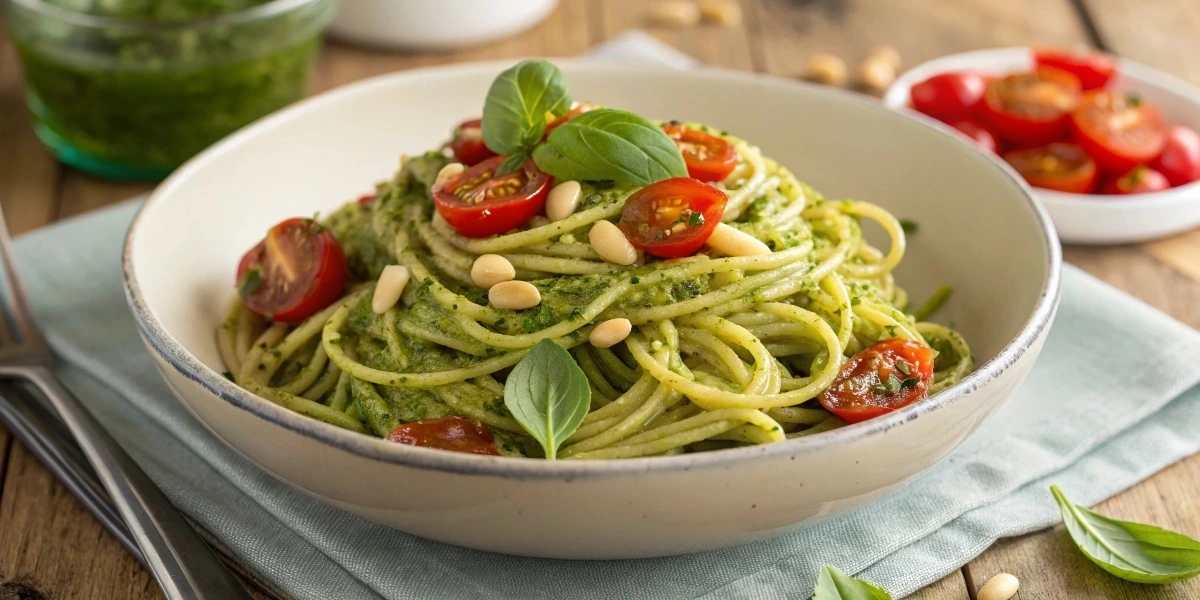Have you ever taken one bite of basil pesto pasta and felt like you were instantly transported to a sunny kitchen in Italy? What makes this simple dish so incredibly satisfying, rich in flavor, and comforting all at once?
If you’re thinking it’s just basil and pasta, think again. There’s magic hidden in the simplicity — a harmony of fresh ingredients that come together in perfect balance. Whether you’re a busy parent, a student on the go, or someone who simply loves good food, basil pesto pasta is your new best friend.
In this article, we’ll explore what makes this recipe a timeless favorite, how easy it is to make, and why it deserves a regular spot on your dinner table. From essential ingredients to step-by-step instructions, creative twists, and smart storage tips — we’ve got you covered!
Table of Contents
Why This Basil Pesto Pasta Recipe Stands Out
Let’s face it — not all pasta dishes are created equal. But when you make basil pesto pasta , you’re choosing more than just a meal. You’re choosing:
- Freshness : Every bite bursts with garden-fresh flavor.
- Speed : Ready in under 30 minutes!
- Ease : Only a few ingredients, but maximum taste.
- Versatility : Perfect for vegetarians, customizable for everyone.
This isn’t your average weeknight pasta. It’s a celebration of flavor, made from scratch without any fancy tools or hours in the kitchen.
Essential Ingredients for Basil Pesto Pasta

The beauty of basil pesto pasta lies in its simplicity. Here’s what you need to create that unforgettable taste:
The Core Ingredients:
- Fresh Basil Leaves – The star of the show! They give the pesto its vibrant green color and aromatic flavor.
- Extra Virgin Olive Oil – Adds richness and helps blend everything smoothly.
- Garlic Cloves – Just a little adds a punch of flavor.
- Parmesan Cheese (Grated) – Gives the pesto a salty, umami kick.
- Pine Nuts – For a buttery texture and nutty depth.
- Salt & Pepper – To enhance all the flavors.
- Pasta of Choice – Typically spaghetti, linguine, or penne.
Optional Add-ins:
- Fresh cherry tomatoes
- Grilled chicken or shrimp
- Roasted vegetables (like zucchini or bell peppers)
Substitutions & Alternatives:
- Basil substitutes : Spinach or arugula (use more to get that bold flavor).
- Cheese alternatives : Vegan Parmesan or nutritional yeast for a dairy-free version.
- Nuts : Walnuts or almonds if pine nuts are too expensive or unavailable.
- Pasta options : Gluten-free pasta works great too!
Step-by-Step Guide to Making Basil Pesto Pasta

Ready to whip up this delicious dish? Let’s walk through each step — it’s easier than you think!
Step 1: Boil the Pasta
- Bring a large pot of salted water to a boil.
- Cook your favorite pasta according to package instructions until al dente.
- Drain and set aside (don’t rinse!).
👉 Pro Tip: Save a cup of pasta water before draining. It helps loosen the pesto later.
Step 2: Make the Pesto
You can use a blender, food processor, or even a mortar and pestle.
Ingredients:
- 2 cups fresh basil leaves
- 1/3 cup extra virgin olive oil
- 2 garlic cloves
- 1/3 cup grated Parmesan cheese
- 1/4 cup pine nuts
- Salt and pepper to taste
Instructions:
- Place the pine nuts and garlic in the blender first and pulse a few times.
- Add the basil leaves and pulse again until chopped.
- Slowly pour in the olive oil while blending until smooth.
- Stir in the Parmesan cheese.
- Season with salt and pepper.
👉 Pro Tip: If the pesto is too thick, add a tablespoon of warm pasta water or lemon juice to thin it out.
Step 3: Combine Everything
- Toss the cooked pasta into the pesto mixture.
- Mix well until every strand is coated.
- Add a splash of pasta water if needed to loosen the sauce.
Step 4: Serve & Enjoy!
- Plate your basil pesto pasta and top with extra Parmesan and fresh basil leaves.
- Add optional protein or veggies if desired.
Assembly Tips for Flavorful Results
Putting together your basil pesto pasta doesn’t stop at mixing ingredients. A few small touches can elevate your dish from good to amazing:
- Warm the pasta slightly before adding the pesto — this helps the sauce coat the noodles better.
- Don’t overheat the pesto — it’s best served fresh to preserve the bright green color and fresh taste.
- Garnish creatively — try a drizzle of olive oil, a sprinkle of chili flakes, or a handful of microgreens.
- Use high-quality ingredients — especially the olive oil and Parmesan. You can really taste the difference!
Storage & Reheating Tips
Even though basil pesto pasta is best eaten fresh, you can store leftovers or prep ahead with these handy tips:
How to Store:
- Refrigerator : Store in an airtight container for up to 3 days. Keep pesto separate from pasta if possible.
- Freezer : Freeze pesto in ice cube trays for easy single-serve portions. Thaw before using.
How to Reheat:
- Gently warm in a pan on the stove with a splash of water or olive oil.
- Avoid microwaving for best texture.
👉 Pro Tip: To keep pesto green longer, cover the surface with a thin layer of olive oil before storing.
Creative Variations of Basil Pesto Pasta
Want to switch things up? Try these fun twists on classic basil pesto pasta :
Creamy Pesto Pasta
Add a dollop of mascarpone or cream cheese to the pesto for a richer, creamier texture.
Pesto Pasta Salad
Chill the pasta and toss with halved cherry tomatoes, mozzarella balls, and balsamic glaze for a refreshing summer dish.
Chicken Pesto Pasta
Grill or sauté chicken breast and mix into the pasta for a protein-packed meal.
Veggie Lovers’ Version
Mix in roasted broccoli, sun-dried tomatoes, and olives for a hearty vegetarian feast.
Seafood Surprise
Toss in grilled shrimp or scallops for a gourmet twist.
Final Thoughts: Try This Basil Pesto Pasta Today
There’s a reason basil pesto pasta has been loved for generations. It’s fast, flavorful, and full of life. Whether you’re cooking for one or feeding a crowd, this dish never disappoints.
So next time you’re looking for something quick and delicious, skip the takeout and reach for some fresh basil instead. Your taste buds — and your wallet — will thank you.
Remember: The secret to great basil pesto pasta isn’t in complicated steps or rare ingredients — it’s in enjoying the process and savoring every bite.
Happy cooking!
❓Frequently Asked Questions About Basil Pesto Pasta
Q: Is basil pesto pasta healthy?
A: Yes! It’s packed with heart-healthy fats from olive oil and pine nuts, plus vitamins from fresh basil. Just watch your portion of cheese if you’re counting calories.
Q: Can I make pesto without a blender?
A: Absolutely! Use a mortar and pestle to crush garlic, pine nuts, and basil by hand. It takes a bit more elbow grease but gives a lovely rustic texture.
Q: How long does homemade pesto last?
A: In the fridge, it stays fresh for 3–5 days. In the freezer, pesto can last up to 6 months!
Q: Can I make this vegan?
A: Yep! Skip the Parmesan or use a vegan alternative, and you’ve got yourself a vegan-friendly basil pesto pasta .
Q: What kind of pasta is best for pesto?
A: Long noodles like spaghetti or linguine work best because they hold onto the sauce beautifully. Penne or fusilli are also great choices.
Q: Why did my pesto turn brown?
A: Exposure to air causes oxidation. To keep it green, store it with a layer of olive oil on top or blanch the basil first (optional).
If you’re looking to infuse your home with authentic global charm and timeless elegance, look no further than Artisanat Marrakech Maroc — a treasure trove of handcrafted Moroccan décor that brings the soul of North Africa into your living space. Whether you’re redesigning your dining room, cozying up your living area, or adding a touch of exotic flair to your outdoor patio, this collection is filled with unique, artisan-made pieces that elevate any interior.
From richly textured Berber rugs woven by Amazigh women in the Atlas Mountains to intricately carved cedarwood furniture and dazzling zellige tile tables, every item tells a story rooted in centuries-old craftsmanship. You’ll also find stunning decorative accents like engraved brass lanterns, hand-painted ceramics, and plush leather poufs in vibrant colors that add warmth and personality to your décor.
For those who appreciate authenticity, sustainability, and cultural richness in design, Artisanat Marrakech Maroc offers a curated selection of decor that blends seamlessly into modern homes while honoring traditional techniques. So whether you’re searching for a statement piece or subtle accents to refresh your space, be sure to explore their shop on Chairish and bring a piece of Morocco into your world.

Basil Pesto Pasta – Fresh, Easy & Ready in 20 Minutes
Ingredients
Notes
Step-by-Step Guide to Perfect Basil Pesto Pasta
Ready to get cooking? Let’s walk through how to make this delicious dish — it’s easier than you think!Step 1: Boil the Pasta
- Fill a large pot with water and add a big pinch of salt.
- Bring it to a rolling boil.
- Add your pasta and cook according to the package instructions until al dente (a little firm in the center).
- Drain the pasta, but save a cup of the cooking water — it helps make the sauce creamy later!
Step 2: Make the Pesto
- In a blender or food processor, toss in the pine nuts and garlic first. Pulse a few times to break them down.
- Add the fresh basil leaves and pulse again until chopped.
- While the blender is running, slowly pour in the olive oil until everything becomes smooth and creamy.
- Stir in the Parmesan cheese , then season with salt and pepper .
- Taste and adjust as needed. Want it creamier? Add a spoonful of Greek yogurt or a splash of lemon juice.
Step 3: Combine Everything
- In a large bowl, toss your cooked pasta with the pesto until every strand is coated.
- If the sauce feels too thick, add a few tablespoons of the reserved pasta water to loosen it up.
Step 4: Serve & Enjoy!
- Plate your basil pesto pasta and top with extra Parmesan, fresh basil leaves, and a drizzle of olive oil.
- Add grilled chicken or cherry tomatoes if you want to turn it into a full meal.
